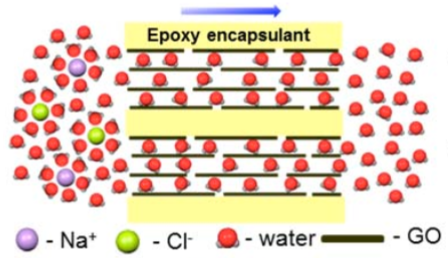Graphene-oxide sieve turns seawater into drinking water
April 13, 2017

Schematic illustrating the direction of ion/water permeation along graphene planes (credit: J. Abraham et al./ Nature Nanotechnology)
British scientists have designed a way to use graphene-oxide (GO) membranes to filter common salts out of salty water and make the water safe to drink.
Graphene-oxide membranes developed at the National Graphene Institute had already demonstrated the potential of filtering out small nanoparticles, organic molecules, and even large salts. And previous research at The University of Manchester also found that if immersed in water, graphene-oxide membranes become slightly swollen and smaller salts flow through the membrane along with water, but larger ions or molecules are blocked.
The researchers have now found a strategy to avoid the swelling of the membrane when exposed to water by building smaller sieves. When the common salts are dissolved in water, they form a “shell” of water molecules around the salt molecules. This allows the tiny capillaries of the graphene-oxide membranes to block the salt from flowing along with the water. Water molecules are able to pass through the membrane barrier and flow faster, which is ideal for application of these membranes for desalination.
“Realization of scalable membranes with uniform pore size down to atomic scale is a significant step forward and will open new possibilities for improving the efficiency of desalination technology,” said The University of Manchester Professor Rahul Nair.
The researchers also believe the atomic scale tunability of the pore size will make it possible in the future to fabricate membranes with on-demand filtration, capable of filtering out ions according to their sizes.
The research was published April 3, 2017 in the journal Nature Nanotechnology.
By 2025 the UN expects that 14% of the world’s population will encounter water scarcity. This technology has the potential to revolutionize water filtration across the world, in particular in countries which cannot afford large scale desalination plants, the researchers suggest.
The goal is to build membrane systems on smaller scales, making this technology accessible to countries that do not have the financial infrastructure to fund large plants without compromising the yield of fresh water produced.
The University of Manchester – The home of graphene | Graphene: Membranes and their practical applications
Abstract of Tunable sieving of ions using graphene oxide membranes
Graphene oxide membranes show exceptional molecular permeation properties, with promise for many applications. However, their use in ion sieving and desalination technologies is limited by a permeation cutoff of ∼9 Å, which is larger than the diameters of hydrated ions of common salts. The cutoff is determined by the interlayer spacing (d) of ∼13.5 Å, typical for graphene oxide laminates that swell in water. Achieving smaller d for the laminates immersed in water has proved to be a challenge. Here, we describe how to control d by physical confinement and achieve accurate and tunable ion sieving. Membranes with d from ∼9.8 Å to 6.4 Å are demonstrated, providing a sieve size smaller than the diameters of hydrated ions. In this regime, ion permeation is found to be thermally activated with energy barriers of ∼10–100 kJ mol–1 depending on d. Importantly, permeation rates decrease exponentially with decreasing sieve size but water transport is weakly affected (by a factor of <2). The latter is attributed to a low barrier for the entry of water molecules and large slip lengths inside graphene capillaries. Building on these findings, we demonstrate a simple scalable method to obtain graphene-based membranes with limited swelling, which exhibit 97% rejection for NaCl.